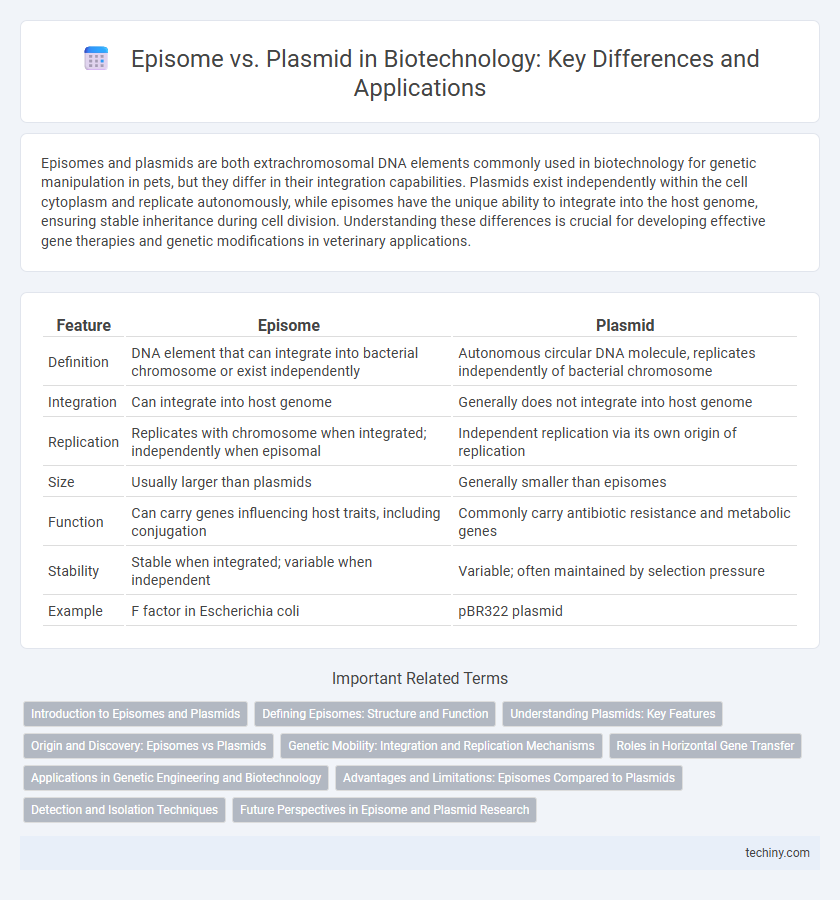Episomes and plasmids are both extrachromosomal DNA elements commonly used in biotechnology for genetic manipulation in pets, but they differ in their integration capabilities. Plasmids exist independently within the cell cytoplasm and replicate autonomously, while episomes have the unique ability to integrate into the host genome, ensuring stable inheritance during cell division. Understanding these differences is crucial for developing effective gene therapies and genetic modifications in veterinary applications.
Table of Comparison
| Feature | Episome | Plasmid |
|---|---|---|
| Definition | DNA element that can integrate into bacterial chromosome or exist independently | Autonomous circular DNA molecule, replicates independently of bacterial chromosome |
| Integration | Can integrate into host genome | Generally does not integrate into host genome |
| Replication | Replicates with chromosome when integrated; independently when episomal | Independent replication via its own origin of replication |
| Size | Usually larger than plasmids | Generally smaller than episomes |
| Function | Can carry genes influencing host traits, including conjugation | Commonly carry antibiotic resistance and metabolic genes |
| Stability | Stable when integrated; variable when independent | Variable; often maintained by selection pressure |
| Example | F factor in Escherichia coli | pBR322 plasmid |
Introduction to Episomes and Plasmids
Episomes and plasmids are extrachromosomal DNA elements that replicate independently within bacterial cells, playing crucial roles in genetic regulation and horizontal gene transfer. Plasmids are circular DNA molecules that exist separately from chromosomal DNA, often carrying genes for antibiotic resistance or metabolic functions. Episomes can integrate into the host genome, enabling stable inheritance and gene expression alongside plasmid-like autonomous replication.
Defining Episomes: Structure and Function
Episomes are specialized genetic elements capable of independent replication and stable integration into the host chromosome, distinguishing them from typical plasmids. Structurally, episomes possess replication origins that enable both autonomous replication and chromosomal incorporation, facilitating gene transfer and horizontal gene exchange. Functionally, episomes play critical roles in bacterial conjugation, antibiotic resistance dissemination, and genetic stability within prokaryotic cells.
Understanding Plasmids: Key Features
Plasmids are extrachromosomal DNA molecules that replicate independently within bacterial cells, typically circular and ranging from 1 to 200 kilobase pairs. Unlike episomes, plasmids do not integrate into the host genome but can carry essential genes for antibiotic resistance, virulence, and metabolic functions. Their ability to transfer between bacteria via conjugation makes plasmids crucial tools in genetic engineering and biotechnology applications.
Origin and Discovery: Episomes vs Plasmids
Episomes were first identified as genetic elements capable of integrating into the host chromosome, discovered in the 1950s through studies on bacterial conjugation and fertility factors in Escherichia coli. Plasmids, which are autonomous, circular DNA molecules independent of chromosomal DNA, were characterized after episomes, with early research in the 1950s and 1960s highlighting their role in antibiotic resistance gene transfer. The key distinction in origin lies in episomes' integration ability into host genomes, whereas plasmids replicate independently, a fundamental concept in molecular cloning and genetic engineering.
Genetic Mobility: Integration and Replication Mechanisms
Episomes possess the unique ability to integrate into the host genome, enabling stable inheritance across generations, whereas plasmids typically replicate independently as extrachromosomal DNA. Integration of episomes facilitates genetic mobility by allowing horizontal gene transfer and chromosomal mutations, impacting bacterial adaptability and evolution. Replication mechanisms differ, with plasmids using theta or rolling-circle replication, while episomes rely on both plasmid replication and host chromosome replication processes.
Roles in Horizontal Gene Transfer
Episomes and plasmids both facilitate horizontal gene transfer (HGT) by moving genetic material between bacteria, but episomes integrate into the host genome, enabling stable inheritance and conjugative transfer, while plasmids typically exist as independent circular DNA molecules that can replicate autonomously. Episomes contribute to the spread of advantageous traits by incorporating genetic elements into the chromosome, enhancing gene stability during cell division, whereas plasmids often carry genes responsible for antibiotic resistance, virulence, or metabolic functions that can be rapidly shared across bacterial populations. The interplay between episomal integration and plasmid mobility drives genetic diversity and adaptation in microbial communities, playing a crucial role in evolutionary processes and biotechnology applications.
Applications in Genetic Engineering and Biotechnology
Episomes and plasmids serve critical roles in genetic engineering, enabling the manipulation and transfer of genetic material in biotechnology. Episomes, capable of integrating into the host genome, provide stable gene expression and are utilized in creating recombinant organisms and gene therapy vectors. Plasmids, widely employed as cloning vectors, facilitate gene cloning, expression studies, and the production of recombinant proteins in bacterial systems.
Advantages and Limitations: Episomes Compared to Plasmids
Episomes offer the advantage of stable inheritance by integrating into the host genome, reducing the risk of loss during cell division compared to plasmids, which replicate independently and can be segregated unevenly. Their integration capacity allows for long-term genetic expression and reduced plasmid copy number variation, enhancing consistency in protein production. However, episomes have limitations such as potential disruption of host genes and more complex manipulation techniques, whereas plasmids provide easier cloning and transient expression with rapid replication in host cells.
Detection and Isolation Techniques
Episomes and plasmids are detected and isolated using techniques such as gel electrophoresis, Southern blotting, and plasmid DNA extraction kits specifically designed to differentiate between autonomous plasmids and episomal DNA integrated into the host genome. Polymerase chain reaction (PCR) with primers targeting episomal or plasmid-specific sequences enables precise identification and quantification. Advanced methods like fluorescence in situ hybridization (FISH) and next-generation sequencing (NGS) further facilitate the distinction by mapping episomal integration sites and plasmid copy numbers within host cells.
Future Perspectives in Episome and Plasmid Research
Advancements in episome and plasmid research are driving innovative gene therapy techniques and synthetic biology applications, with episomes offering stable, long-term gene expression without genome integration risks. Emerging CRISPR-based tools enhance precise episomal modification, expanding their utility in regenerative medicine and vaccine development. Future research aims to optimize episome retention and plasmid delivery systems for improved therapeutic efficacy and biosafety.
episome vs plasmid Infographic

 techiny.com
techiny.com